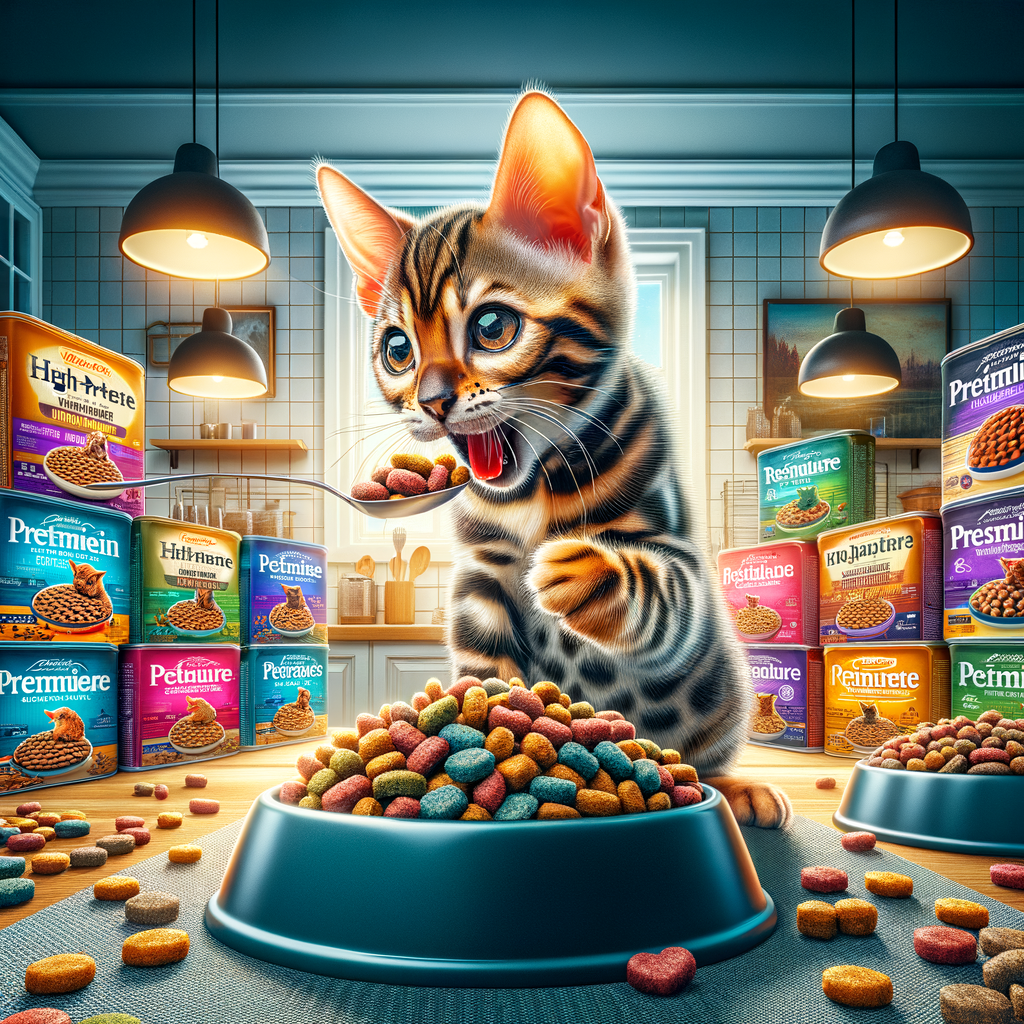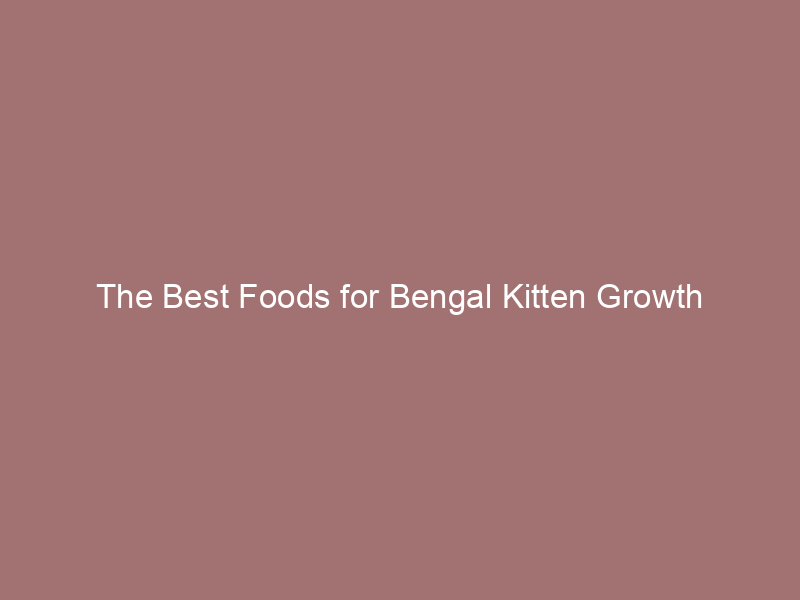
The Importance of a Balanced Diet for Bengal Kittens
- Bengal kitten nutrition
Bengal kittens are active and playful. They need a diet that supports their energy levels and growth. A balanced diet helps them stay healthy and strong.
- Role of a balanced diet in Bengal kitten growth
It helps them grow properly and develop strong muscles and bones. Without the right nutrients, they may face health issues.
- Key nutrients for Bengal kittens
There are several key nutrients that Bengal kittens need:
-
- Protein: Helps build muscles and tissues.
- Fats: Provide energy and support brain development.
- Vitamins and Minerals: Essential for overall health and immune function.
| Key Nutrient | Importance |
|---|---|
| Protein | Builds muscles and tissues |
| Fats | Provides energy and supports brain development |
| Vitamins and Minerals | Essential for overall health and immune function |
High-Protein Food for Bengal Kittens
Why Protein is Essential
- Role of protein in muscle development: These kittens are very active and need good muscle strength to support their playful nature.
- Recommended protein content in Bengal kitten diet: Experts suggest that Bengal kittens should have a diet with at least 30-40% protein. This ensures they get enough nutrients for healthy growth and energy.
Best High-Protein Kitten Food Brands
- Blue Buffalo Wilderness Kitten FoodBlue Buffalo Wilderness offers a high-protein formula that is perfect for Bengal kittens. It contains real chicken as the first ingredient, ensuring your kitten gets the protein needed for muscle growth. This brand also includes DHA for brain development and omega-3 and omega-6 fatty acids for a healthy coat.
Protein Content Main Ingredients Special Features 40% Chicken, Fish Meal, Peas DHA for brain development, Omega fatty acids - Wellness CORE Grain-Free Kitten Formula: Wellness CORE is another excellent choice for high-protein kitten food. It is grain-free and packed with protein from turkey and chicken. This formula also includes antioxidants, probiotics, and taurine, which are essential for your Bengal kitten’s overall health.
Protein Content Main Ingredients Special Features 45% Turkey, Chicken Meal, Peas Antioxidants, Probiotics, Taurine - Orijen Cat & Kitten Food: Orijen Cat & Kitten Food is known for its high-quality ingredients and high protein content. This brand uses fresh and raw animal ingredients, providing a diet that is biologically appropriate for Bengal kittens. It also includes a variety of meats, ensuring a balanced diet.
Protein Content Main Ingredients Special Features 42% Chicken, Turkey, Fish Fresh and raw ingredients, Variety of meats
Grain-Free Food for Bengal Kittens
Benefits of Grain-Free Diet
Feeding your Bengal kitten a grain-free diet can be very beneficial. Here are some key advantages:
- Improved digestion: Grain-free foods are often easier for Bengal kittens to digest. This can lead to better nutrient absorption and overall health.
- Reduced risk of allergies: Some kittens are allergic to grains. A grain-free diet can help reduce the risk of allergic reactions, keeping your kitten happy and healthy.
Wet vs Dry Food for Bengal Kittens
Pros and Cons of Wet Food
- Pro: High moisture content
Wet food has a lot of water. This helps keep your Bengal kitten hydrated. Kittens need more water to stay healthy. Wet food can be very good for their kidneys and bladder.
- Con: Shorter shelf life
Wet food does not last long once opened. You need to store it in the fridge. It can spoil quickly if left out. This means you need to be careful about how you store and serve it.
Pros and Cons of Dry Food
- Pro: Convenient to serve: Dry food is easy to measure and serve. You can leave it out for your Bengal kitten to nibble on throughout the day. This is especially helpful if you have a busy schedule.
- Con: Lower moisture content: Dry food has less water compared to wet food. Bengal kittens need enough water to stay healthy. If they eat only dry food, make sure they drink plenty of water.
Bengal Kitten Feeding Guide
Feeding Schedule
- Recommended feeding times: Bengal kittens need to eat more frequently than adult cats. It’s best to feed them 3-4 times a day. Here’s a simple schedule you can follow:
- Morning: 7:00 AM
- Midday: 12:00 PM
- Afternoon: 5:00 PM
- Evening: 9:00 PM
- Portion sizes: The amount of food your Bengal kitten needs depends on their age and weight. Here’s a general guide:
Age (Months) Weight (lbs) Portion Size (cups per meal) 2-3 2-3 1/4 4-6 3-5 1/3 7-12 5-8 1/2 Always check the food packaging for specific recommendations and adjust portions as needed based on your kitten’s activity level and growth.
Transitioning to Adult Food
- When to start the transition: Bengal kittens should start transitioning to adult food around 12 months of age. This is when they are fully grown and need different nutrients to stay healthy.
- How to make the transition smoother: To make the change easier, mix a small amount of adult food with their kitten food. Gradually increase the adult food over 7-10 days. This helps their tummy get used to the new food.
Ensuring Healthy Growth for Your Bengal Kitten
Ensuring your Bengal kitten grows up healthy and strong requires attention to several key areas. Here, we highlight the importance of regular vet check-ups and monitoring your kitten’s growth and development.
- Importance of regular vet check-ups: These check-ups help catch any health issues early. According to veterinary experts, early detection can make treatment easier and more effective. Your vet will also provide necessary vaccinations and advice on diet and care.
- Monitoring your kitten’s growth and development: Keep an eye on your kitten’s weight, height, and overall behavior. A healthy Bengal kitten should be active and playful. Use a growth chart to track their progress. If you notice any sudden changes, consult your vet immediately.
| Key Aspect | Details |
|---|---|
| Regular Vet Check-ups | Helps in early detection of health issues, provides vaccinations, and offers diet and care advice. |
| Monitoring Growth | Track weight, height, and behavior. Use a growth chart and consult the vet for any sudden changes. |






